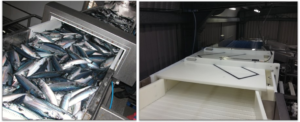 |
Irish pelagic fishers and processors are joining an international scientific initiative to provide vital information which helps inform the management of Northeast Atlantic mackerel, one of Ireland’s most valuable species.
BIM is working in collaboration with the Marine Institute and pelagic fishers and processors to install mackerel scanners in processing plants in Killybegs, Co Donegal. Two units have been installed with further units to be fitted in factories over the next two years, with grant aid from the European Maritime, Fisheries and Aquaculture Fund (EMFAF).
“Mackerel remains Ireland’s most valuable wild caught export, valued at €95m in 2022 said Dr Michael Gallagher, Pelagic Sector Manager, BIM. “Given the importance of mackerel to the Irish seafood industry, it is critical that we collaborate to collect the best quality data for this valuable resource.
“BIM and the Marine Institute work closely together and we saw a real opportunity to reach out to fishers and processors to progress this initiative. Dr Edward Farrell of Killybegs Fishermen’s Organisation has also played a central role in coordinating the installation and set-up of the scanners.”
Dr Andrew Campbell, Pelagic Fisheries team lead, Marine Institute, highlighted the importance of robust scientific data. “In addition to annual scientific surveys and the triennial mackerel egg survey, tag-return data from this type of study also yields invaluable stock structure and age composition insights,” said Dr Campbell. “This data feeds into assessments to allow meaningful catch limits to be set for sustainable management.”
Two tagging units installed in Killybegs at the end of last year are already capturing important data. “In total, 66 tagged fish have been detected to date and we are hopeful that more valuable tag return data will be generated from the Irish mackerel fishery as more scanning units are installed in cooperation with the pelagic industry,” said Dr Campbell.
Up to 2011, mackerel were tagged by inserting small metal tags into the abdomen of the fish before release, which were then picked up by metal detectors at processing plants when the tagged fish were caught. This labor intensive, manual process meant workers had to sift through the mackerel to pick out the tagged fish each time they heard the metal detector ping on processing lines.
“The international tagging programme has actually been in operation for over 55 years,” said Dr Edward Farrell, Chief Scientific and Sustainability Officer, KFO. “Over 40,000 fish have been tagged annually, which is done simply by jigging for mackerel on surveys in the North Sea and off the west coast of Ireland and west of Scotland.
“In 2011, Radio Frequency Identification (RFID) replaced these metal tags and now when the tagged fish pass through the scanners in processing plants, valuable data is automatically collected without any need to touch the fish.”
BIM is hosting a pelagic information session on 29 September at KFO offices in Killybegs where this project and other topics will be shared. To register for this in person and online event, please visit Eventbrite.
Background
Northeast Atlantic (NEA) mackerel is one of Ireland’s most valuable species landed, with €80 million landed by Irish vessels in 2022, an increase of 10 per cent in value from 2021. Mackerel is also Ireland’s most valuable wild caught seafood export, valued at €95 million in 2022.
The Institute of Marine Research in Bergen (IMR) has conducted tagging experiments on mackerel on annual basis since 1968, both in the North Sea and to the west of Ireland during the spawning season May–June. Approximately 40,000-50,000 mackerel are tagged annually. Mackerel caught in the wild have small tags inserted which are later automatically detected by scanning units in processing plants before being processed and sold. The data is captured in real time and shared with the IMR. The RFID data have been used to construct a new abundance index which has been used in the mackerel stock assessment since 2017. This information is imperative as it contributes to the understanding of mackerel distribution and stock assessment, and feeds into the International Council for the Exploration of the Sea (ICES) assessment model.
ENDS